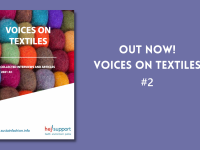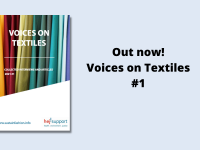Bio-based Polyester – Rejecting the Use of Petroleum in Fashion

Polyester represents a significant market share of the textile industry, accounting for more than 75% of all synthetic fibers.1 Unfortunately, the vast majority of polyester production is reliant on fossil fuel-based resources, which are not sustainable and risk market volatility due to their finite nature.1 To reduce the industry’s reliance on these petroleum-based resources, bio-based polyesters have emerged as a more sustainable alternative.1
As defined by the Polymer Properties Database, bio-based polyesters are “a large class of bioplastics that are derived from renewable resources such as natural fats and oils”.2
Bio-based polyesters currently under development and those available for commercial use include bio-based polyethylene terephthalate (PET), polylactic acid (PLA), polytrimethylene terephthalate (PTT), polyglycolic acid (PGA), monoethylene glycol (MEG), and polyhydroxybutyrate (PHB) as well as many others.2,3
A number of major companies have been involved in the development of these new bio-based chemicals, such as DuPont, Gevo, NatureWorks and Virent.3
Although there are a variety of sustainability standards for bio-based feedstock, they are not widely used for biosynthetic production.3 One exception is the use of the ISCC Plus standard by NatureWorks for the bio-based feedstock of its polylactic acid.3
While there is mounting interest in biosynthetics, bio-based polyester currently amounts to less than 1% of total polyester production.3 Public commitments to bio-based polyester are scarce, with retailers more frequently committing to the use of recycled polyester.3
If uptake is improved, bio-based polyester can mitigate the environmental impacts of polyester production through reduced greenhouse gas emissions.3 In order to achieve this objective, responsible sourcing and management of bio-based polyester is essential.3
References
- Textile Exchange. (2018). Quick guide to biosynthetics. Retrieved from: https://textileexchange.org/wp-content/uploads/2018/01/Textile-Exchange-Quick-Guide-To-Biosynthetics-2018.pdf
- Polymer Properties Database. (2021). Biobased polyesters: Properties and applications. Retrieved from: https://polymerdatabase.com/Polymer%20Brands/Biopolyesters.html
- Opperskalski, S., Siew, S., Tan, E., & Truscott, L. (2020). Preferred fiber & materials market report 2020. Textile Exchange. Retrieved from: https://textileexchange.org/wp-content/uploads/2020/06/Textile-Exchange_Preferred-Fiber-Material-Market-Report_2020.pdf






